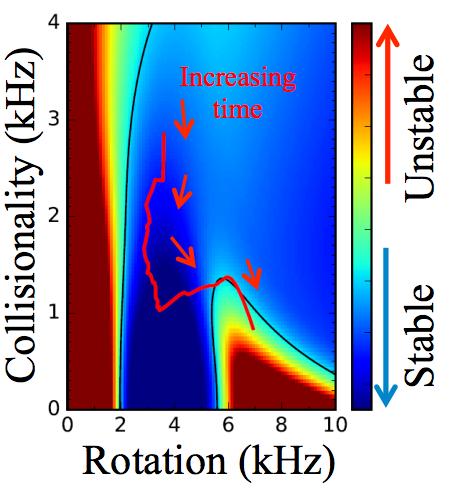Steering a fusion plasma toward stability

Stability map of fusion plasma in NSTX. Blue is stable and red is unstable. As the plasma decreases collisionality and increases rotation in time it transitions into an unstable region. Credit: Princeton Plasma Physics Laboratory
Plasmas in fusion-energy producing devices are gases heated to millions of degrees that can carry millions of amperes of current. These superhot plasmas must be kept away from material surfaces of the vacuum vessel that contains them by using strong magnetic fields. When the gas becomes unstable it can touch the chambers' walls, quickly cooling the plasma and disrupting fusion reactions.
Such disruption could potentially harm the walls of future fusion-producing devices. Drs. Jack Berkery and Steve Sabbagh from Columbia University, who work at the U.S. Department of Energy's Princeton Plasma Physics Laboratory (PPPL), have developed a potential way to avoid these instabilities.
Fusion scientists previously thought that making the plasma rotate would stabilize the plasma, but Sabbagh and Berkery discovered that there is a more complicated connection between rotation and stability. Some plasmas can become unstable when they rotate too fast, while others can maintain stability at lower rotation rates.
When plasma rotation is kept in a favorable range, the charged plasma particles bouncing back and forth in the magnetic field can actually steal some of the energy from the rotational motion, which helps stabilize the plasma. A similar stability condition applies to the frequency with which particles collide and bounce off one another, a property termed their collisionality.
Berkery and Sabbagh found that reduced collisionality, as will be found in future fusion plasmas, does not necessarily lead to reduced stability, overturning long-held beliefs on the effect of collisions on stability.
Using these ideas, the scientists developed a “stability map” that allows a plasma to be monitored in real-time — with 1/1000 of a second resolution — to determine whether it is stable and how close it is to being unstable. If you know how fast the plasma is rotating and the collisionality, you can use the stability map to see if the plasma is stable, as shown (Figure 1) for an experiment at the National Spherical Torus Experiment at PPPL.
The red colored areas are unstable, and the blue areas are stable. As the plasma evolves in time, indicated by the arrows on the map, its collisionality decreases and its rotation increases. These changes lead the plasma to become unstable, and confinement of the plasma is lost, disrupting the fusion reaction. Controlling the rotation based on the stability map may allow steering the plasma back to a stable region, thereby avoiding disruption of the fusion reaction.
###
Along with two European colleagues, Drs. Berkery and Sabbagh recently won the Landau-Spitzer award, presented jointly by the American and European Physical Societies for outstanding contributions to plasma physics, for their work in understanding the stability of fusion plasmas.
Contacts:
Jack Berkery
609-243-2497
jberkery@pppl.gov
Steve Sabbagh
609-243-2645
sabbagh@pppl.gov
Abstract Y12.00005
Resistive Wall Mode Stability Forecasting in NSTX and NSTX-U
9:30 AM-12:30 PM, Friday, November 4, 2016, Room: 210 CDGH
Media Contact
All latest news from the category: Power and Electrical Engineering
This topic covers issues related to energy generation, conversion, transportation and consumption and how the industry is addressing the challenge of energy efficiency in general.
innovations-report provides in-depth and informative reports and articles on subjects ranging from wind energy, fuel cell technology, solar energy, geothermal energy, petroleum, gas, nuclear engineering, alternative energy and energy efficiency to fusion, hydrogen and superconductor technologies.
Newest articles

High-energy-density aqueous battery based on halogen multi-electron transfer
Traditional non-aqueous lithium-ion batteries have a high energy density, but their safety is compromised due to the flammable organic electrolytes they utilize. Aqueous batteries use water as the solvent for…

First-ever combined heart pump and pig kidney transplant
…gives new hope to patient with terminal illness. Surgeons at NYU Langone Health performed the first-ever combined mechanical heart pump and gene-edited pig kidney transplant surgery in a 54-year-old woman…

Biophysics: Testing how well biomarkers work
LMU researchers have developed a method to determine how reliably target proteins can be labeled using super-resolution fluorescence microscopy. Modern microscopy techniques make it possible to examine the inner workings…





















